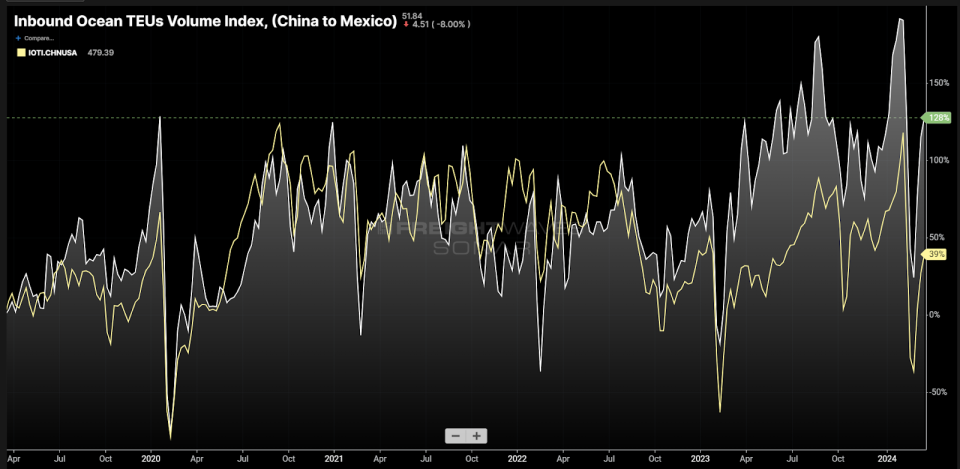Is Mexico becoming the new China?


Chart of the Week: Import Ocean TEUs Index – China to Mexico, China to USA SONAR: IOTI.CHNMEX, IOTI.CHNUSA
Import bookings have doubled from China to Mexico compared to the same period in 2019, with the bulk of the increase coming in the past year. By contrast, import bookings from China to the U.S. are up a still-impressive approximately 40%, but nothing like the Mexico figure. What does this mean for the U.S. freight market?
The Inbound Ocean TEUs Indices (IOTI) measure bookings of twenty-foot equivalent units on a 14-day rolling average based on departure date from the port of lading. They are representative of maritime shipping container demand and a leading indicator of surface transportation demand.
Earlier this month, FreightWaves’ Noi Mahoney wrote about the skyrocketing container shipment growth in this lane based on analysis from Xeneta. While it is nearly impossible to say definitively what is driving this growth, some of the driving theories make strong logical sense.
Nearshoring has been getting a lot of the headlines over the past several years thanks to growing geopolitical tensions, especially with China.
It is not widely discussed that China is nearly as dependent on the U.S. consumer as America is on China’s production. China is actively pursuing solutions to this as many American companies look to diversify their production. One of those solutions may be manifesting in the import data.

U.S. freight demand has been steadily growing in every mode since the most recently concluded winter. The number of TEUs clearing customs (CSTEU) was up 11% y/y last week, loaded rail container volumes (ORAILL) were up a similar amount, and the national Outbound Tender Volume Index (OTVI) was up 10%.
All three figures show a steadily increasing trend line. The rapid growth in imports in the China-to-Mexico lane is much sharper and expands beyond the organic growth of the American imports.
There are a few theories as to why this is occurring. One of the most popular and somewhat commonsensical is that China and/or its sourcing partners are bypassing tariffs by bringing goods into Mexico before sending them across the border, essentially making them “Mexican” imports and avoiding tariffs. This will be difficult for the U.S. to prove and/or enforce.
A second theory is that China is sending more raw materials into Mexico as it is investing in the country’s manufacturing sector, expecting that the U.S. will be more willing to deal with its Southern neighbor for trade.
If these two theories hold true, then the North American supply chain will continue to see an evolution to more freight coming across the Southern border.
It is difficult to tell if the inbound Mexico imports have eroded any share from the U.S. at this point, thanks in large part to the still-unstable shipping environment created by the pandemic.

Import bookings into the Port of Los Angeles are up 40% annually, with Long Beach increasing 11%. The IOTI from China to Mexico has somewhat mirrored the Los Angeles import bookings trend over the past year.

The Laredo, Texas, and Tucson, Arizona, markets are two of the fastest-growing in the U.S. over the past five years. Laredo tender volumes are up 137% versus March of 2019, and Tucson’s are up 237%. Both are home to large border crossing points.
China cannot be replaced by nearshoring alone, but this is not the only path forward. Whether it is nearshoring, tariff bypasses or something else entirely, the Southern border is increasingly important for domestic transportation.
About the Chart of the Week
The FreightWaves Chart of the Week is a chart selection from SONAR that provides an interesting data point to describe the state of the freight markets. A chart is chosen from thousands of potential charts on SONAR to help participants visualize the freight market in real time. Each week a Market Expert will post a chart, along with commentary, live on the front page. After that, the Chart of the Week will be archived on FreightWaves.com for future reference.
SONAR aggregates data from hundreds of sources, presenting the data in charts and maps and providing commentary on what freight market experts want to know about the industry in real time.
The FreightWaves data science and product teams are releasing new datasets each week and enhancing the client experience.
To request a SONAR demo, click here.
The post Is Mexico becoming the new China? appeared first on FreightWaves.
